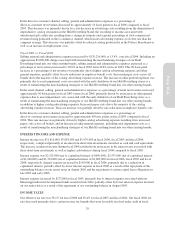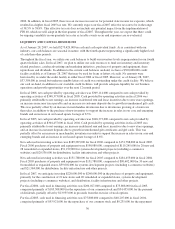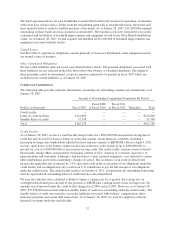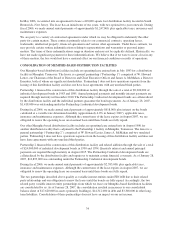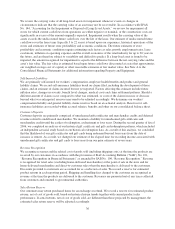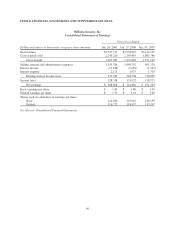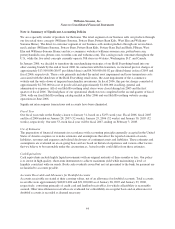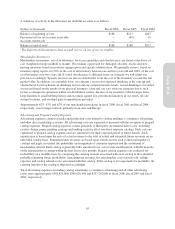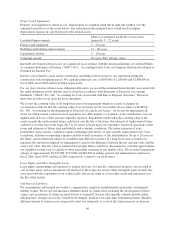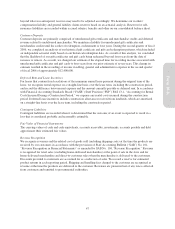Pottery Barn 2006 Annual Report Download - page 49
Download and view the complete annual report
Please find page 49 of the 2006 Pottery Barn annual report below. You can navigate through the pages in the report by either clicking on the pages listed below, or by using the keyword search tool below to find specific information within the annual report.
Income Taxes
Income taxes are accounted for using the asset and liability method. Under this method, deferred income taxes
arise from temporary differences between the tax basis of assets and liabilities and their reported amounts in the
consolidated financial statements. We record reserves for estimates of probable settlements of foreign and
domestic tax audits. At any one time, many tax years are subject to audit by various taxing jurisdictions. The
results of these audits and negotiations with taxing authorities may affect the ultimate settlement of these issues.
Our effective tax rate in a given financial statement period may be materially impacted by changes in the mix and
level of earnings.
Stock-Based Compensation
On January 30, 2006, we adopted SFAS No. 123R, “Share-Based Payments,” which required us to measure and
record compensation expense in our consolidated financial statements for all employee stock-based
compensation awards using a fair value method. For stock options and stock-settled stock appreciation rights
(“option awards”), fair value is determined using the Black-Scholes valuation model, while restricted stock units
are valued using the closing price of our stock on the date prior to the date of issuance. Significant factors
affecting the fair value of option awards include the estimated future volatility of our stock price and the
estimated expected term until the option award is exercised. The fair value of the award is amortized over the
expected service period. Prior to fiscal 2006, we accounted for stock-based compensation arrangements using the
intrinsic value method in accordance with Accounting Principles Board Opinion No. 25, “Accounting for Stock
Issued to Employees” and related interpretations. Accordingly, no compensation expense was recognized prior to
fiscal 2006 for option awards with an exercise price equal to the fair value on the date of grant. See Note I to our
Consolidated Financial Statements.
NEW ACCOUNTING PRONOUNCEMENTS
On January 30, 2006, we adopted FSP FAS 13-1, “Accounting for Rental Costs Incurred During a Construction
Period,” which requires us to expense all rental costs associated with our operating leases that are incurred during a
construction period. The adoption of this Staff Position resulted in after-tax occupancy expense of approximately
$1,439,000, or $0.01 per diluted share, in fiscal 2006 and is recorded as a component of cost of goods sold.
In June 2006, the FASB issued FIN 48, “Accounting for Uncertainty in Income Taxes – An Interpretation of
FASB Statement No. 109,” which prescribes a recognition threshold and measurement attribute for the financial
statement recognition and measurement of a tax position taken or expected to be taken in a tax return.
Additionally, FIN 48 provides guidance on the derecognition, classification, interest and penalties, accounting in
interim periods, transition and disclosure requirements for uncertain tax positions. We will adopt the provisions
of FIN 48 beginning in the first quarter of fiscal 2007. We are currently in the process of determining the effect
the adoption of FIN 48 will have on our consolidated financial statements.
In June 2006, the FASB’s Emerging Issues Task Force (“EITF”) reached a consensus on Issue No. 06-3, “How
Taxes Collected from Customers and Remitted to Governmental Authorities Should Be Presented in the Income
Statement (That Is, Gross versus Net Presentation).” The scope of EITF 06-3 includes sales, use, value added and
some excise taxes that are assessed by a governmental authority on specific revenue-producing transactions
between a seller and customer. EITF 06-3 requires disclosure of the method of accounting for the applicable
assessed taxes and the amount of assessed taxes that are included in revenues if they are accounted for under the
gross method. EITF 06-3 is effective for interim and annual periods beginning after December 15, 2006. We
present revenues net of any taxes collected from customers and remitted to governmental authorities. We do not
expect the adoption of EITF 06-3 to have an impact on our consolidated financial position, results of operations
or cash flows.
As of January 28, 2007, we adopted the evaluation requirements of Staff Accounting Bulletin (“SAB”) No. 108,
“Considering the Effects of Prior Year Misstatements When Quantifying Misstatements in Current Year Financial
Statements,” which provides the Staff’s views regarding the process of quantifying financial statement
misstatements, such as assessing both the carryover and reversing effects of prior year misstatements on the current
year financial statements. The adoption of SAB No. 108 did not have a material impact on our consolidated
financial position, results of operations or cash flows in fiscal 2006.
37
Form 10-K




